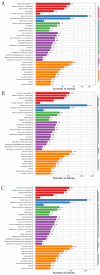Identification of microRNAs in Silver Carp (Hypophthalmichthys molitrix) Response to Hypoxia Stress
- PMID: 34679939
- PMCID: PMC8696637
- DOI: 10.3390/ani11102917
Identification of microRNAs in Silver Carp (Hypophthalmichthys molitrix) Response to Hypoxia Stress
Abstract
Hypoxia is one of the serious stresses in fish culture, which can lead to physical and morphological changes, and cause injury and even death to fish. Silver carp (Hypophthalmichthys molitrix) is an important economic fish and widely distributed in China. MicroRNA is a kind of endogenous non-coding single-stranded small RNA, which is involved in cell development, and immune response and gene expression regulation. In this study, silver carp were kept in the closed containers for hypoxia treatment by spontaneous oxygen consumption. The samples of heart, brain, liver and gill were collected, and the total RNAs extracted separately from the four tissues were mixed in equal amounts according to the concentration. Afterwards, the RNA pool was constructed for high-throughput sequencing, and based on the small RNA sequencing, the differentially expressed microRNAs were identified. Furthermore, their target gene prediction and enrichment analyses were carried out. The results showed that a total of 229 known miRNAs and 391 putative novel miRNAs were identified, which provided valuable resources for further study on the regulatory mechanism of miRNAs in silver carp under hypoxia stress. The authors verified 16 differentially expressed miRNAs by qRT-PCR, and the results were consistent with small RNA sequencing (sRNA-seq). The predicted target genes number of differentially expressed miRNAs was 25,146. GO and KEGG functional enrichment analysis showed that these target genes were mainly involved in the adaption of hypoxia stress in silver carp through biological regulation, catalytic activity and apoptosis. This study provides references for further study of interaction between miRNAs and target genes, and the basic data for the response mechanism under hypoxia stress in silver carp.
Keywords: Hypophthalmichthys molitrix; high-throughput sequencing; hypoxia stress; microRNA; silver carp.
Conflict of interest statement
All authors declare no conflict of interest.
Figures




Similar articles
-
Identification and Characterization of Immune-Associated MicroRNAs in Silver Carp (Hypophthalmichthys molitrix) Responding to Aeromonas veronii and LPS Stimulation.Animals (Basel). 2024 Jan 17;14(2):285. doi: 10.3390/ani14020285. Animals (Basel). 2024. PMID: 38254454 Free PMC article.
-
Liver Transcriptome and miRNA Analysis of Silver Carp (Hypophthalmichthys molitrix) Intraperitoneally Injected With Microcystin-LR.Front Physiol. 2018 Apr 10;9:381. doi: 10.3389/fphys.2018.00381. eCollection 2018. Front Physiol. 2018. PMID: 29692738 Free PMC article.
-
Comparative transcriptome analysis provides novel insights into the molecular mechanism of the silver carp (Hypophthalmichthys molitrix) brain in response to hypoxia stress.Comp Biochem Physiol Part D Genomics Proteomics. 2022 Mar;41:100951. doi: 10.1016/j.cbd.2021.100951. Epub 2021 Dec 15. Comp Biochem Physiol Part D Genomics Proteomics. 2022. PMID: 34923202
-
Physiological responses and molecular strategies in heart of silver carp (Hypophthalmichthys molitrix) under hypoxia and reoxygenation.Comp Biochem Physiol Part D Genomics Proteomics. 2021 Dec;40:100908. doi: 10.1016/j.cbd.2021.100908. Epub 2021 Aug 27. Comp Biochem Physiol Part D Genomics Proteomics. 2021. PMID: 34482099
-
Silver Carp (Hypophthalmichthys molitrix) (Asian Silver Carp) Presence in Danube Delta and Romania-A Review with Data on Natural Reproduction.Life (Basel). 2022 Oct 12;12(10):1582. doi: 10.3390/life12101582. Life (Basel). 2022. PMID: 36295017 Free PMC article. Review.
Cited by
-
Identification and Characterization of Immune-Associated MicroRNAs in Silver Carp (Hypophthalmichthys molitrix) Responding to Aeromonas veronii and LPS Stimulation.Animals (Basel). 2024 Jan 17;14(2):285. doi: 10.3390/ani14020285. Animals (Basel). 2024. PMID: 38254454 Free PMC article.
-
MicroRNAs May Play an Important Role in Sexual Reversal Process of Chinese Soft-Shelled Turtle, Pelodiscus sinensis.Genes (Basel). 2021 Oct 25;12(11):1696. doi: 10.3390/genes12111696. Genes (Basel). 2021. PMID: 34828302 Free PMC article.
-
Rainbow trout integrated response after recovery from short-term acute hypoxia.Front Physiol. 2022 Oct 21;13:1021927. doi: 10.3389/fphys.2022.1021927. eCollection 2022. Front Physiol. 2022. PMID: 36338491 Free PMC article.
-
Integrated miRNA-seq and functional analyses reveal the regulatory role of sha-miR-92a_L + 2R + 4 via targeting vegfaa in rainbow trout (Oncorhynchus mykiss) responding to acute hypoxia and reoxygenation stress.BMC Genomics. 2024 Dec 2;25(1):1163. doi: 10.1186/s12864-024-11019-1. BMC Genomics. 2024. PMID: 39623322 Free PMC article.
-
Molecular cloning, characterization and expression analysis of P53 from high latitude fish Phoxinus lagowskii and its response to hypoxia.Fish Physiol Biochem. 2022 Jun;48(3):631-644. doi: 10.1007/s10695-022-01072-6. Epub 2022 Apr 11. Fish Physiol Biochem. 2022. PMID: 35411444
References
-
- Rudolf S.S.W. Hypoxia: From molecular responses to ecosystem responses. Mar. Pollut. Bull. 2002;45:35–45. - PubMed
-
- Pollock M.S., Clarke L.M.J., Dubé M.G. The effects of hypoxia on fishes: From ecological relevance to physiological effects. Environ. Rev. 2007;15:1–14. doi: 10.1139/a06-006. - DOI
-
- Ruan W., Ji W.W., Zheng L., Yue D.D., Fang H. On hypoxia stress in fish and its nutritional regulation and response. Mar. Fish. 2020;42:751–761.
-
- Thomas O’.C., David W. Linking hypoxia to shrimp catch in the northern Gulf of Mexico. Mar. Pollut. Bull. 2007;54:460–463. - PubMed
Grants and funding
LinkOut - more resources
Full Text Sources
Research Materials

